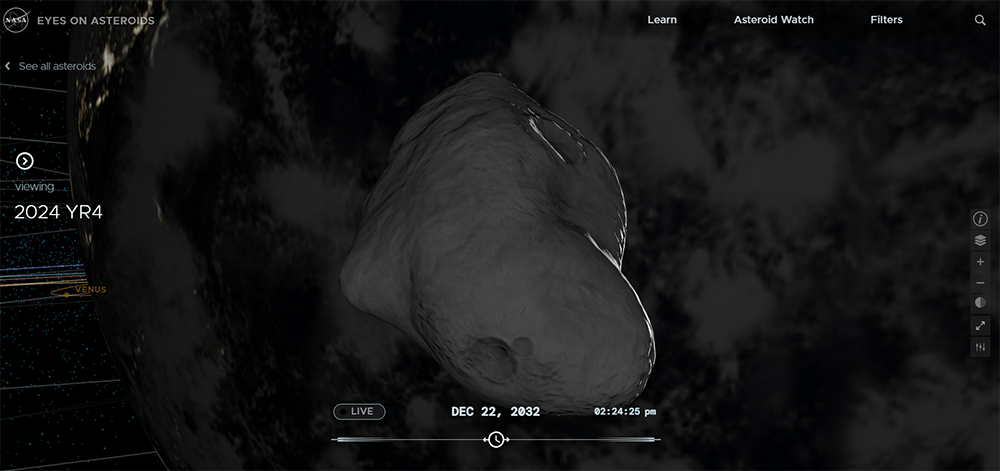NASA has issued a statement on asteroid 2024 YR4, a newly discovered asteroid with an over 1 percent chance of hitting Earth within the next decade.
ADVERTISEMENT GO AD FREE
Asteroid 2024 YR4 was first discovered by the Asteroid Terrestrial-impact Last Alert System (ATLAS) in Chile in late December last year. In what could be considered “not the best Christmas present” from the Solar System, observations showed that the object has a higher chance of impact with Earth than almost all asteroids we have discovered so far. Before you panic, this will likely change as more observations of the asteroid are made.

Animation of asteroid 2024 YR4’s closest approach to Earth.
Image credit: NASA’s Eyes On Asteroids
Near-Earth Objects (NEOs), particularly NEOs above 140 meters (460 feet) in size, are tracked by NASA and other astronomers and assessed for risk of impact with Earth. As part of this, they are given a “Torino” impact score of 0-10, with a score of 0 meaning the likelihood of impact is zero or thereabouts, and 10 meaning “a collision is certain, capable of causing global climatic catastrophe that may threaten the future of civilization as we know it, whether impacting land or ocean.” These are helpfully color-coded in green, yellow, and red, to clarify the situation to the public.
Until asteroid 2024 YR4 was discovered, there were a grand total of zero (0) objects with a score higher than zero. The object, which is thought to be about 40 meters (130 feet) to 91 meters (300 feet) wide has been placed at Level 3 on the Torino scale due to a particularly close approach on December 22, 2032. On that day, it is currently predicted to pass the Earth at a minimum distance of 0.00001 Astronomical Units (AU), with 1 AU being the distance between the Earth and the Sun. That’s about 1,500 kilometers (930 miles), which in astronomical terms is very close indeed, and closer to the Earth than many satellites. According to EarthSky, the asteroid currently has around 1-in-83 odds of colliding with Earth during that approach.
While a little closer than is ideal, follow-up observations are expected to provide some reassurance.
“A close encounter, meriting attention by astronomers. Current calculations give a 1 percent or greater chance of collision capable of localized destruction,” NASA explains of Level 3. “Most likely, new telescopic observations will lead to re-assignment to Level 0. Attention by public and by public officials is merited if the encounter is less than a decade away.”
Should the object impact Earth, it would not be a world-ender due to its relatively small size. However, it is around the size of the asteroid responsible for the Tunguska Event, the largest impact in recorded history, which is thought to have been about 50 to 80 meters (160–262 feet). Depending on where it hit (if we are unlucky enough to be hit by it) it could cause similar levels of devastation.
ADVERTISEMENT GO AD FREE
Over the years of monitoring space objects, astronomers have discovered few objects that have strayed from that reassuring green zone. However, there have been a couple that made it to level 4; the highest level of the yellow zone.
One of these objects was 99942 Apophis. After it was first discovered in 2004, observations placed it at level 2 on the Torino scale. However, further observations in December of that year placed it up to level 4 due to a 1.6 percent chance that the asteroid would hit us in 2029. Even further observations ruled out a collision in 2029, as well as in 2036 and 2068, though they will still be close encounters.
In all likelihood, 2024 YR4 will be downgraded to Level 0 as further observations are made, hopefully long before the close approach in seven years time. Until then, NASA has stepped in to provide a little reassurance on the matter.
“NASA analysis of a near-Earth asteroid, designated 2024 YR4, indicates it has a more than 1 percent chance of impacting Earth on Dec. 22, 2032 – which also means there is about a 99 percent chance this asteroid will not impact,” the US government agency said in a blog post. “Such initial analysis will change over time as more observations are gathered.”
ADVERTISEMENT GO AD FREE
The agency added that no other asteroids have a probability this high of hitting Earth. However, they stress, as we have above, that other asteroids have been given high Torino scores which were downgraded after further observations.
“An object that reaches this level is not uncommon; there have been several objects in the past that have reached this same rating and eventually dropped off as more data have come in,” they write. “New observations may result in reassignment of this asteroid to 0 as more data come in. ”
Source Link: NASA Issues Statement On Newfound Asteroid With 1 Percent Chance Of Hitting Earth In 2032